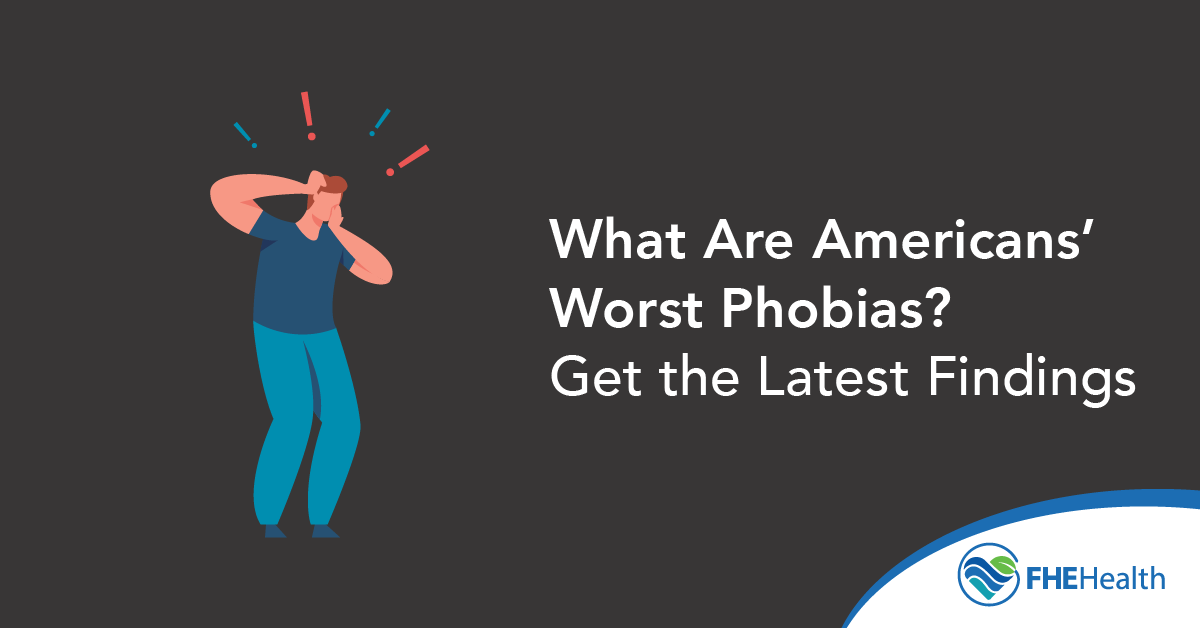
In an effort to explore Americans’ most common fears and how these relate to phobias, we recently conducted a large-scale survey of a broad sample of the U.S. population and asked respondents to tell us what they were most afraid of. The goal was to better understand the relationship between people’s worst fears and phobias (two distinct yet related phenomena) and the driving force behind phobias in particular. This article offers some in-depth fear statistics and explores the prevalence of phobias and how they develop.
First, What Is a Phobia?
A phobia is an intense, chronic and irrational fear of something specific. Most phobias involve something that can be dangerous or harmful, but a person responds more intensely than the level of potential risk warrants, which is what makes a phobia irrational by definition.
For example, phobias involving spiders, germs and heights are commonplace, and these things truly could be dangerous. Spider bites can be risky, germs can cause disease and falling from a high place can cause fatal injury. However, phobias often arise in situations when the subject of fear doesn’t pose a threat to the person experiencing the phobia. For instance, a person with acrophobia (a fear of heights) may still be affected by this crippling fear on higher stories of a building, even when surrounded by walls and windows.
Specific phobias fit into a category of documented anxiety disorders — conditions where anxiety, panic, fear and worry detract from a person’s ability to function normally, either on a chronic (long-term) or acute (temporary) basis.
According to the National Institutes of Health, more than 30% of people will suffer from an anxiety disorder at some point in their lives. In many cases, the anxiety relates to, or becomes, a phobia.
The Prevalence of Phobias in America
According to the Anxiety & Depression Association of America, 19.3 million U.S. adults are affected by a phobia. Women are more than twice as likely to experience specific phobias compared to men.
People also experience phobias in varying degrees. The Sheehan Disability Scale can be used to rate phobias based on how they affect a person’s ability to lead their daily lives.
Using this scale, the most common form of phobia is the one that causes the lowest level of impairment. Around 48% of respondents said they suffered from a mild phobia, 30% reported the effects of their disorder were moderate and 22% experienced extreme phobic impairment.
Symptoms of Phobia
Phobia symptoms tend to manifest in stages. People don’t have to be physically exposed to the source of their fear. In fact, just thinking about a specific phobia can induce a feeling of dread, fear and anxiety.
When presented with phobic stimuli, someone with a phobia may experience nausea, panic attacks, sweating, increased heartbeat, elevated blood pressure and difficulty breathing. This experience can lead to an internalization of the response so that, over time, a person becomes habituated to reacting in the same way. Feelings of worthlessness, low self-esteem and the urge to make lifestyle changes to avoid exposure at all costs in the future are also common outcomes.
Avoiding phobia triggers can worsen a phobia by reinforcing the fear. Exposure therapy can help gradually reduce phobias by helping a person learn that the feared situation isn’t unsafe.
What Causes Phobias to Develop?
Many fears are understandable — spiders, snakes, heights and illnesses are among the most common fears faced by a large segment of the population. But how do extreme fears become documented phobias?
Although nothing is certain in this regard, scientists and mental health researchers believe there are two primary causes of phobias:
- Adverse experiences. It’s believed that a traumatic experience can cause a phobia to develop. Treatment for post-traumatic stress disorder and treatment for phobias are often heavily linked and discussed in the same breath.
- Genetic links. In some cases, phobias appear to be hereditary, but it’s essential to recognize the difference between a genetic phobia and one that results from being forced to experience a parent or guardian’s phobia secondhand.
A fear becomes classed as a phobia when the fear response is out of proportion to the actual danger, that response lasts for 6 months or longer and it significantly interferes with a person’s day-to-day life. A strong and even irrational response to a fear trigger that passes quickly when the situation is gone isn’t necessarily a phobia. However, if a person starts avoiding certain situations or taking excessive precautions in an attempt to avoid a fear, they may have developed a phobia.
Common Myths About Phobias
There are some myths about phobias that can pose obstacles to treatment. Here are just a couple:
- Phobias and fears are the same. In most cases, fear is natural. It’s your nervous system’s way of taking action against something that could put your health or safety at risk. Phobias occur when the fear response isn’t proportional to the threat posed by a given source and causes a nervous system overreaction.
- People who struggle with phobias are crazy. The stigma that presides over mental health in society is dangerous, and this applies to the urge to conclude that a person can be qualified as crazy. To a degree, everyone is affected by their mental health at some point in their lives, and ultimately, it’s no different than coming down with a virus that makes you physically ill.
Our Phobias Survey Results — The Most Common Fears
So, what are the most common phobias and fears? To find out, we surveyed 200 individuals, asking some basic demographic questions and scoring topics on fear. At the beginning of our survey, we asked respondents to provide their own answers regarding their top fears before we asked them about specific topics. The bulk of our survey addressed common objects of fear, scoring them on a 1-10 scale (with 1 being “not scared at all” and 10 being “terrified”). Using the scores assigned to each topic, we were able to calculate a total “fear score” based on all the respondents’ ratings.
So, the most common fears are:
- Dying
- Spiders
- Financial issues
- Darkness
- Depression
When we asked respondents to rate certain events, actions or scenarios based on how scary they were, the responses were similar. For example, loss of a loved one, injury or illness and personal poor health were all in the top 10. Spiders were ranked in the top five scary things.
Fears are quite common, with 62% of the people surveyed agreeing that they considered themselves someone who has fears and another 10% strongly agreeing with that statement. Only 3% strongly disagreed with it.
When faced with a situation they fear, most people reported experiencing a racing heart. Other common responses included feeling upset, screaming, crying or shutting down. One unexpected but not uncommon response to fear is to start laughing.
When Should You Seek Treatment?
When phobias are mild, they don’t affect your life to the same degree more severe phobias do. If you’re irrationally afraid of snakes, for example, maybe you’ll skip a trip to the zoo with friends. If you have a phobia of elevators, you’ll take the stairs whenever possible. These are inconveniences, but ultimately they don’t affect your ability to lead a healthy, functional life.
However, some of the most common fears can completely halt your life — especially if you find yourself exposed to them often in your line of work or in common social situations. If your anxiety detracts from your ability to live the life you want, it’s time to consult a professional.
Phobia treatment can take many forms, ranging from conventional treatments such as psychotherapy or talk therapy, consisting of sessions with a licensed counselor, to more extreme treatments, including controversial methods of exposure therapy.
Reach Out
At FHE Health, we see countless people every day who struggle with anxiety disorders, including specific phobias. You don’t have to continue missing out on experiences because of your most common fears. Contact us today to learn about your options for getting high-quality help from addiction and mental specialists in South Florida.






